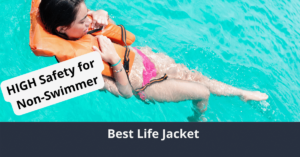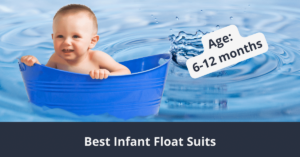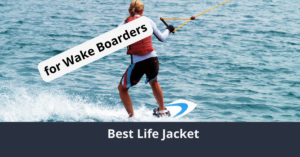Having a baby around water can be nerve-racking. But you may want to get your infant accustomed to the water at the pool or keep them safe on the boat. The best life jackets for infants fit well, are comfortable, and keep your little one on their backs until help can reach them in the water.
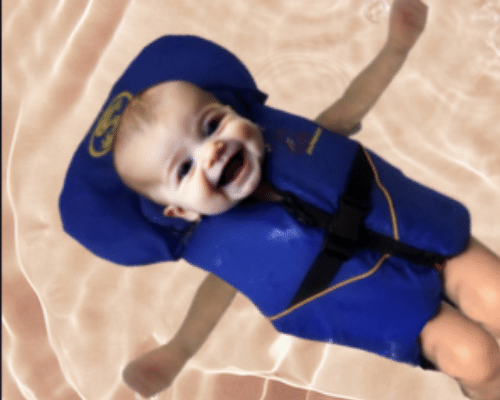
Because there are so many options to choose from, we’ve made it easier by compiling baby life jacket reviews. We’ll go over the pros and cons of different styles and explain what you should consider when buying a life vest for an infant or newborn.
Most infant life jackets fit kids that weigh up to 30 pounds, but many also have a lower weight limit of 8 or 9 pounds. We’ll go over size, fit, and safety concerns in the buyer’s guide section of this article.
If your kid weighs between 15 to 30 pounds then read our article: Best Life Jackets for 15 to 30 pounds Toddlers
Everything you will learn here
- The Best Infant Life Jacket for 1 Year old Babies
- 1. Stearns Heads-Up Child Vest
- 2. Airhead WICKED Kwik-Dry Neolite Flex Life Vest
- 3. Stearns 2000019828 PFD 5402 Hydro Infant
- 4. O’Neill Wake Waterski Infant USCG Vest
- 5. Full Throttle Infant Baby-Safe Vest
- 6. White Knuckle Infant/Baby Neoprene USCG Approved Life Vest
- 7. Stearns Infant Puddle Jumper Hydroprene Fish Print Life Jacket
- 8. Stohlquist Toddler Life Jacket Coast Guard Approved Life Vest for Infants
- 9. Airhead Infant Life Vest
- 10. Free Swimming Baby Inflatable Baby Swimming Float Ring
- Life Jackets for Infants Buyers Guide – Making the Best Purchase
- Benefits of Life Jackets for Infants
- Safety Features of the Best Infant Life Jackets
- Types of Life Jackets for Infants
- Questions to Ask Before Buying a Life Jacket for Infants
- Infant Life Vest Terms to Understand
- Steps for Safely Using an Infant Life Vest
- Safety Advice
- Best Life Jackets for Infants Comparison Chart
- Wrap Up
The Best Infant Life Jacket for 1 Year old Babies
Personal flotation devices, or PDFs, for infants can help save your child’s life in the water. Life jackets are designed to help your child keep their head out of the water until help arrives. They’re meant to be used with constant adult supervision. Never leave a baby alone in the water.
The following reviews list our top picks for the best life jackets for babies. They’re in no particular order. Read through them to find out more about baby life vests.
1. Stearns Heads-Up Child Vest
- USCG Approved: Approved by the United States Coast Guard for use
- For kids weighing up to 30lbs
- Heads-up neck float designed for face-up flotation
This life vest comes in infant, youth, and child sizes. The infant size is perfect for children that weigh 15 to 30 pounds. This PFD is excellent for little ones because it comes in a bright, lime-green hue that will help your infant stand out in the water.
It’s also a reliable device that’s made out of high-quality materials. The crotch strap is covered in hydroprene, allowing it to fit snugly while remaining comfortable. The PFD is made mostly from nylon and polyester for quick-drying, resilient performance.
The neck support on some PFDs can feel bulky. This one lies flat and out of the way while your little one is on dry land. It floats upward to support the head when it’s submerged in the water.
(Want the same vest in youth size, read our article: Best Youth Life Vests)
Pros:
- Unique, visible color
- Comfortable crotch strap
- USCG-approved
- Less bulky than some other type II PFDs
Cons:
- Not ideal for infants that weigh less than 15 pounds
- Armholes may feel snug
- Might work best for infants that are little older or bigger
Is your child a little bit older than 1 year already? We have listed the best life jackets here:
2. Airhead WICKED Kwik-Dry Neolite Flex Life Vest
- USCG APPROVED – this personal flotation device meets USCG requirements for a Type II (Infant) and III (Child) Life Vest. Closed sides, buckle and zipper closures, additional crotch belt and rapid rescue handle for safety and peace of mind
- COMFORT and SAFTEY - Less bulky design for use when quick response is likely, offers a larger range of motion making it a favorite for water activities. Closed sides, zipper, crotch strap and double buckle closure keep life jacket securely in place, quick grab rescue handle provides a secure grip/lift option
- MATERIAL - Durable, Quick-drying, and super soft PFD. This fabric stays comfortable against your child’s skin. Quick Dry Neolite is designed to wick away moisture and feel light and airy for a full day of fun on the water
This is one of the least bulky infant life vests around. It’s also extremely lightweight, and it’s a type III PFD that’s approved for infants that weigh up to 30 pounds.
The sides are enclosed. This life vest closes with a front zipper but has an adjustable strap to make the waist snugger. However, it won’t expand if your little one’s belly is growing out of it.
The quick-drying material is breathable. It’s also soft and minimizes chafing against your child’s skin. The fabric is UV and stain-resistant, so it’s meant to last.
Pros:
- Slim, not bulky at all
- Unique coloring and patterns
- Quick-drying NeoLite material
- USCG-approved
Cons:
- Enclosed sides are not expandable
- Zipper may rub against child’s neck
- Head support pillow may push child’s face forward
3. Stearns 2000019828 PFD 5402 Hydro Infant
- US Coast Guard-approved infant life jacket
- Oversized head support encourages face-up flotation
- Made with a soft Hydroprene shell and durable Crosstech flotation foam
This streamlined vest is lightweight and comfortable for little ones. It slips onto your child like shorts and the buckles close at the shoulder. This design keeps the PFD down around the hips and prevents it from floating up.
Instead of a single crotch strap, two straps surround the legs and keep the PFD in place. They’re adjustable so that you can alter them as your little one grows.
The rear zipper is difficult for a little one to reach. Therefore, you can be certain that your baby won’t undo the fasteners while they’re in the water. However, it’s easy for an adult to glide the zipper up and down for easy entry and exit.
Pros:
- Not very bulky
- Lightweight
- USCG-approved
- Comfortable hydroprene shell
Cons:
- Small neck hole
- More comfortable in the water than out of the water
- Zipper might be a little difficult to reach
4. O’Neill Wake Waterski Infant USCG Vest
- Infant vest for 30lbs and under
- USCG Approved Vest Head Support Panel with Safety Loop
- Adjustable Safety Belt between legs
This life vest is USCG-approved for use on boats and by the water. The neoprene shell is soft, and the foam inside is lightweight. It features a front zipper and safety straps around the abdomen.
This is an ideal life vest for active water sports. Even though your infant won’t be participating in the sports, they’ll likely be out in open water that may be slightly rough. They need a life vest that stands up to this type of activity.
This type II vest is supposed to flip kids over to encourage back floating. However, you might need to encourage your child to lean back to prevent their face from being held forward under the water.
Pros:
- Quick zipper entry and exit
- Soft neoprene shell
- V-neck doesn’t put pressure on neck
- Comes in several bold colors
Cons:
- May be large on smaller babies
- Not ideal for teaching kids how to swim
- Kids might need to lean back with the vest if they’re back floating
5. Full Throttle Infant Baby-Safe Vest
- Oversized collar for improved head support
- Convenient buckle opening at collar makes it easy to put on
- Elasticized fabric leg strap for added comfort
This life vest looks like a little cocoon. It has wide neck support to hold your child’s head up and tapers toward the crotch to make it more comfortable to move around in. It’s perfect for young babies that can’t walk yet.
Adults have plenty of room on the sides and back to hold onto the child’s body. A grab loop behind the head also makes your child easily accessible in the water.
This PFD fastens easily. You simply slide your child into it, situate the feet with the elastic crotch strap between the legs, and secure the buckles. Adjust the life vest until it’s snug and doesn’t ride up.
Pros:
- USCG-approved
- Excellent for non-mobile infants
- Oversized neck support
- Adjustable neck strap expands the head opening
Cons:
- Crotch elastic collects water
- Bulkier than most
- Might not work as well for bigger or older babies
6. White Knuckle Infant/Baby Neoprene USCG Approved Life Vest
- Rated for 30lbs (fits 10-20lbs)
- US Coast Guard Approved
- hidden nylon belts and hinge points for maximum comfort
This life vest is designed for older infants. It fits children that weigh between 20 and 30 pounds.
If you’re looking for a streamlined vest that won’t feel too bulky on your baby, this one might work for you. It has additional details to enhance its sleek profile. The straps are hidden beneath the fabric, for example. Your child won’t be able to play with or get caught in the belts.
This life vest does not have neck support. It is not designed to encourage back flotation. Therefore, it may be better suited for an older infant that knows how to swim. It’s not the best PFD for boating.
(Want to view the best boating vests, please visit: Best Life Vests for Boating)
Pros:
- Kids can’t mess with hidden belts
- Sides are hinged for mobility
- PVC foam is comfortable and long-lasting
- USCG-approved
Cons:
- Closed sides aren’t expandable
- Zipper might irritate the neck
- No head/neck support
7. Stearns Infant Puddle Jumper Hydroprene Fish Print Life Jacket
- US Coast guard-approved life jacket
- Great for a day on the boat or beach and in the pool or lake
- For use on a boat, a personal watercraft or for tow sports
Many life jackets for infants are bulky. This one is sleek and lightweight. It’s plenty buoyant without the added heft. Therefore, it’s excellent for babies who are crawling or toddling. The PFD is designed for babies that weigh under 30 pounds.
The oversized head support promotes back floating. However, the design doesn’t work like this for everyone. Some children get stuck on their stomachs if they fall forward while wearing this life jacket. However, if the water is deep enough, a child should flip to their back once their feet are not making contact with the ground.
This puddle jumper is made of extremely soft hydroprene. This material is durable and comfortable for wearing all day. The Crosstech flotation foam is lightweight and not too bulky.
Pros:
- Oversized head support
- Two leg straps are secure and comfortable
- Made of super-soft hydroprene
- USCG-approved
Cons:
- Neck opening is not adjustable
- Doesn’t always flip kids onto their backs
- Neck hole might be a little big for smaller infants
8. Stohlquist Toddler Life Jacket Coast Guard Approved Life Vest for Infants
- FEEL COMFORTABLE IN THE WATER - Made of soft foam for maximum comfort, this child personal floatation device comes with a convenient grab collar for easy retrieval. The head support collar offers the security for them to play and be happy in the water
- BUCKLE UP - The single quick release front buckle provides added security and even has an adjustable crotch strap to fit any size. You'll notice the durability of this infant life vest from the box stitched buckle attachment that'll have you using this for years to come
- FEEL THE MOVEMENT - Life vests can be iritating for children. That's why we've made sure to design this infant PFD with full arm mobility so you can enjoy watching them play and swim
This minimalist life jacket has plenty of buoyancy in a lightweight, streamlined profile. It contains almost no material in the back. The design makes it easy for children to move their arms freely, helping them stay mobile in and out of the water.
Also, the V-neck cradles the chin without being too restrictive. This life vest should be comfortable for infants to wear all day.
This PFD provides sea-level buoyancy for children that weigh between 7 pounds and 30 pounds. Keep in mind that it won’t flip all children over to a face-up position.
The flotation foam and other materials are concentrated in the front. The life vest fastens with a zipper in the front. It also has an adjustable belt that fits over the zipper for added security. The adjustable crotch strap prevents the life vest from riding up.
Pros:
- Comes in a variety of high-visibility colors
- USCG-approved
- Allows for full arm mobility
- Double collar cradles the head
- Straps won’t twist or tangle
Cons:
- Doesn’t flip all children onto their backs in the water
- Bulky around the sides
- Doesn’t include reflectors
9. Airhead Infant Life Vest
- Closed sided vest with crotch strap included for extra safety and segmented head rest and grab handle
- Three sturdy belts with side-release buckles
- USCG approved Type II
If your little one complains about wearing a life vest, this one might make things more fun. The bright yellow color is highly visible, and the cute duck face on the head support is enticing for young kids. The PFD also comes in a blue color with a picture of a hippo. That one isn’t as visible as the duck version.
This life vest has plenty of buckles, which adjust to create the perfect fit. It works for infants that weigh between 15 and 30 pounds.
The life jacket is as durable as it is adorable. The shell material is UV-resistant and should stand up to a full summer in the sun.
Pros:
- Many adjustable buckles
- Segmented headrest
- Cute design
- UV-resistant material
- USCG-approved
Cons:
- Closed sides restrict the expansion on the abdomen
- Not suitable for small infants
- Bulkier than some other life vests
10. Free Swimming Baby Inflatable Baby Swimming Float Ring
- 【NEWER MODEL】 Newer pool float come with a breathable and removable sun canopy to protects baby’s skin away from sun,enjoying summer time anytime,anywhere.
- 【EXTRA WIDE FOR STABILITY】10% Wider and 10% Longer than other Baby Floats; Includes Non-inflatable sponge chest support to protects the baby belly.
- 【ACTIVE PLAY & SPLASH】Baby pool float provide an ideal swimming posture for babies, gives your little one the freedom to kick their legs with excitement as you cool off in the pool together.
This float ring is not a life-saving device, nor is it USCG-approved. However, it might be a valuable addition to your water activities if you plan to take your baby in the pool or shallow water. It allows your infant to be comfortable in the water while keeping them afloat and holding their head far from the water’s surface.
The flotation device comes in three different sizes. Small is suitable for infants that weigh 11 to 24 pounds. Large works for children that weigh between 13 and 38 pounds.
The raised front prevents the baby from tipping forward in the water. A soft crotch strap feels like a diaper and prevents the child from falling through the ring.
Pros:
- Helps baby get comfortable in a swimming position
- Deflates and folds compactly for storage
- Great for babies that want to float in the pool
- Made of durable PVC
- Inflates quickly
Cons:
- Not a USCG-approved life-saving device
- You have to blow it up before use
- Sizes might run a little small
Life Jackets for Infants Buyers Guide – Making the Best Purchase
Ultimately, the best life jackets for babies are safe and effective. They prevent your infant from sinking or dropping their face in the water. But life jackets must also be comfortable. If your infant feels compressed or pinched, they might not tolerate the life jacket. And a life jacket doesn’t serve any purpose if the child isn’t wearing it.
Benefits of Life Jackets for Infants
There are several benefits of life jackets for babies. Of course, they help protect your infant from drowning when they’re used properly.
However, they’re not completely failsafe. A life jacket might not work as well in rough water as it does in calm water. A PFD that’s designed to keep your baby face up may not do so if the child is flailing frantically.
But most drownings don’t happen out at sea. Nine out of ten drownings happen in inland waters. Many occur close to safety. It only takes 20 seconds for an infant to drown. Life jackets give rescuers time to act.
Life jackets have other benefits. They can help parents and caregivers feel more comfortable bringing their babies around water. In turn, this gives the infant more opportunities to get used to swimming and water activities.
Some life vests are swim aids. These may provide buoyancy, but they’re not always approved by the U.S. Coast Guard. No matter what kind of life jacket you choose, never stay more than arm’s reach from your infant in the water.
If you are boating or have the potential to be separated from your child in an accident, choose the type of life jacket that will flip an unconscious person on their back, and test it out before your outing.
Safety Features of the Best Infant Life Jackets
When it comes to water-related accidents, kids under the age of four have the highest drowning rates. As a parent, this can be scary, but the good news is that infant life jackets have come a long way. If you’re interested in keeping up with current statistics, our website has an interactive resource for US Drowning Statistics, Worldwide Drowning Statistics, and Drowning Prevention.
They’re Visible
Life vests come in bright colors, such as red, orange, and yellow, to enhance the individual’s visibility. If someone is lost at sea, they’ll be more easily spotted in a bold color than a dull one.
Some life vests have reflectors, which aid in search-and-rescue efforts. Most of the life vests for babies that you’ll find don’t have reflectors, but they might have strong hues. If your little one is mobile, a bright color or unique pattern will help you keep an eye on them at the pool or beach.
They Keep Your Child Afloat
Life vests for babies are typically made from lightweight foam. They’re rated to support children in a specific weight range. Most infant life vests fit children that weigh less than 30 pounds. If your child weighs more than the maximum on the PFD label, the device might not keep them afloat.
They Keep the Head Out of Water
Many infant life vests have extra foam around the head and neck. This acts as a support that keeps the child’s head above water. When this design is combined with a PFD that has more foam in the front than the back, it will flip an infant onto their back in the water.
The ability to flip your child over automatically isn’t guaranteed, though. You should always test out a life vest before you commit to it. Make sure that it flips your baby over whether they’re calm or moving around.
They’re Adjustable
Because life jackets for babies are meant to fit kids in a wide weight range, they must be adjustable so that you can snug them up to your infant’s size. Even if it has a zippered opening, which makes it easy to get in and out of, it should have straps that make the body tighter or looser. These life jackets should also have a crotch strap to keep everything in place.
They’re Easy to Grab
Infant life vests have a grab loop behind the neck. This feature helps parents get a handle on their children while they’re in the water. A wide grab loop makes it easy to rescue an infant that has fallen in.
They’re Comfortable
You might not think of comfort as a safety feature. However, if a life vest doesn’t feel good, your infant is not going to want to wear it.
Most life jackets are made of nylon or neoprene. Nylon is inexpensive, but neoprene might be a better option. It’s softer and more durable than nylon. Neoprene also repels water better than some other materials, keeping your little one warm.
Types of Life Jackets for Infants
There are several types of life jackets that are approved by the U.S. Coast Guard Foundation, or USCG. You should look for a type I, II, or III life vest. Here’s the difference:
- Offshore Life Vest – A type I life vest provides the most reliable flotation. These are usually bright and visible. They should turn most people over onto their backs if they’re unconscious. However, these are usually the bulkiest types of life jackets for infants.
- Near-Shore Buoyant Life Vest – A type II life vest is ideal for use in inland waters, where rescue could occur quickly. These are less bulky than type I PFDs but not as reliable. They may not encourage back flotation in all users.
- Flotation Aid – A type III life vest is usually the most comfortable for long hours of wear. However, this type of PFD is not recommended for non-swimmers. Therefore, it may not be the best choice for an infant.
Although boating regulations vary from state to state, the law requires all boaters under the age of 13 to wear a USCG-approved life vest. Therefore, the type of life vest that you choose may depend on the type of water activity that you’re doing.
If you just want something to provide added buoyancy while you’re hanging out in the pool with your baby, you might not need a USCG-approved PFD.
You might come across inflatable type I, II, and III life vests. These are designed for people over the age of 16. They’re not suitable for infants.
The USCG does not recommend bringing small infants on boats. That’s because they can’t guarantee the fit of a life vest for a child that weighs less than 18 pounds. However, bringing a baby on a boat isn’t against the law. Just make sure that they’re properly fitted with an infant life jacket.
Questions to Ask Before Buying a Life Jacket for Infants
Before buying a life jacket for infants, ask yourself the following questions:
How Much Does My Child Weigh Right Now?
Buy a life jacket based on your child’s current weight. Don’t get an extra-large one in hopes that it will continue to fit your infant for several years. You’ll need to make sure that the life vest fits properly every year, and you may need to purchase replacements frequently for a growing child.
(If your kid is 30-50 pounds or around 3 to 7 years old, then you should read: Best Kids Life Jackets)
Is it Bright Enough?
Take a look around the next time you go to the beach or pool. What color are most of the kids wearing? Red? Blue? Choose a life vest in a contrasting color so that you can easily spot your kids in the water.
Where Will My Child Wear it?
The location of where your child will wear the life vest matters a lot—if you’re on a boat or out in the open water, you’ll want to make sure that your baby or toddler is wearing a USCG-approved vest.
Infant Life Vest Terms to Understand
Here are a couple of key terms to understand if you’re browsing the features of infant life vests:
- Crotch strap – A strap that goes between the legs can prevent a life jacket from riding up.
- Grab handle – A loop at the neck gives adults an easy hand-hold for grasping their child in slick water.
- Adjustment straps – Lots of adjustment straps will help the PFD fit your little one perfectly.
- Head support – Foam padding around the neck and chest area can keep your toddler’s head above water.
- Removable foam – If you’re using a device for swimming education instead of personal flotation, you might want to look for an option with removable foam. You can reduce the buoyancy as your child becomes a more confident swimmer.
Steps for Safely Using an Infant Life Vest
There are a few steps that you should follow to use a life vest properly. Don’t rush. Make sure that you help your child get used to the life jacket before using it on the water. You should also ensure that the device works properly for your child’s size.
1. Put It on Your Child
It seems obvious, but a life vest won’t work if your child doesn’t wear it. Many parents place a life vest on a boat or pier near their child. If your little one has an accident and falls in the water, you won’t have time to grab the life vest. Therefore, you should always have it properly secured on your infant while you’re near the water.
2. Test it on Land
Try the life jacket on several times before you commit to using it in the water. First, try it on when you’re at home, and your little one is in a good mood. Make a game of it, and have some fun. If your infant fusses, don’t push it. You can always try again later or another day.
Once your infant is happy wearing the life jacket, you can make sure that it fits properly. Adjust all of the straps as appropriate. The jacket should be snug but not so tight that you have trouble closing the fasteners.
When the PFD is adjusted securely, try to lift it at the shoulders. It should not come up and cover your child’s face. You may feel as though the fit is snug around the neck. That’s because infants tend to have short, chubby necks.
If this is a problem, look for a life vest with a V-neck or wide neck opening. Even if the neck opening is wide, the life vest still shouldn’t ride up when you tug on the shoulders.
Getting your baby used to the life vest out of the water is essential. Once they’re comfortable with the fit, you can test it out in the water.
3. Start in the Shallow End
Make sure that you take things gradually when testing out a life vest for babies in the water. If your child is afraid of or uncomfortable in the water, you don’t want to make any sudden moves too quickly. This is where getting your baby used to the life vest on dry land will come in handy. If they’re already accustomed to wearing the PFD, it will be a familiar experience.
Begin in shallow water. Show your child how to lie back while wearing the life vest. Stay by your child, and keep your hands on your infant if it makes them feel more secure. Spend lots of time smiling and talking to your baby to make this a stress-free experience.
4. Show Your Child What to Do
Children may panic if they fall into the water. Therefore, it’s crucial to get them accustomed to being in the water. Show them how to float and relax. If you do this every time you put them in the life vest, they’re much more likely to know what to do if they’re ever in trouble.
It’s never too early to show your infant how to float on their back. Practice flipping them from a face-down to face-up position if you can do so safely while they’re wearing the life jacket. When your little one knows how to right themselves, they’ll be safer around water.
Safety Advice
A life vest is not a babysitter. You should be just as vigilant as you would be if your little one weren’t wearing a life vest.
You should also store and maintain the life vest properly. The fabric can deteriorate from UV radiation as well as regular wear and tear. Allow the PFD to dry between uses. Don’t store it in a dark, moist place. It could become damaged if it develops mold.
The PFD can also be damaged by the sun’s rays. Don’t leave it out in direct sunlight. Let it dry in the shade.
Avoid crushing the PFD. If you store it under other heavy items, the foam could become compressed. If it does, it won’t function optimally.
Secure all of the straps. They’re meant to be there, so make sure that all of the buckles are fastened and adjusted snugly.
But you should never strap your baby into a car seat while they’re in a boat or on the water. Even if the child is wearing a life vest, they won’t be buoyant enough if the seat falls overboard.
Best Life Jackets for Infants Comparison Chart
| Product Name | Price | Safety | Size | Other Value Added Features | Color |
|---|---|---|---|---|---|
| Stearns Heads-Up Child Vest | $ | Contoured Float above the Neck | 23"-17" | Personal Flotation Device | Green/ Gray |
| Airhead Wicked Kwik-Dry Neolite Flex Life Vest | $ | Zipper Closure with 2 adjustable belts | 15.5"-12.8" | Soft UV and stain resistant | Hot Pink |
| Stearns 20000019828 PFD 5402 Hydro Infant | $ | Leg straps and Grab handle for extra safety | 17.4"-12.7" | Head support for face up flotation | Red/ Pink |
| O•Neill Wake Waterski Infant USCG Vest | $ | Adjustable Safety Belts and Buckles | 13.19"-12.83" | Ultravoilet Protection | Berry/Graphite/Smoke |
| Full Throttle Infant Baby-Safe Vest | $ | Encircling waist belt ensures a secure fit | 12.5"-11.5" | Lightweight with head support | Orange/Grey |
| White Knuckle Infant/Baby Neoprene USCG Approved Life Vest | $ | Three adjustable belts with quick release Buckles | 15.9"-14.3 | Soft Neoprene on Shoulders | White |
| Stearns Infant Puddle Jumper Hydroprene Fish Print Life Jacket | $ | 2 adjustable leg straps ensure safety | 17.1"-13.9" | Grab handles allows to easy remove child | Blue |
| Stohlquist Toddler Life Jacket Coast Guard Approved Life Vest for Infants | $ | Convenient Grab Handle to make rescue a breeze | 15.6"-12.3" | Straps won't twist or tangle | Aqua/Pink |
| Airhead Infant Life Vest | $ | Three sturdy belts with side release buckles | 18.5"-12" | Segmented head rest | Yellow |
| Free Swimming Baby Inflatable Baby Swimming Float Ring | $ | Dual Airbag and sounding belts | 8.4"-7.8" | Easy to inflate and deflate | Blue |
Wrap Up
The USCG recommends that you don’t bring young infants on boats if you can avoid it. However, if you do have to bring your little one on a vessel with you, you need a USCG-approved life jacket.
If you’re just hanging out in the pool or at the lake, you can choose a swim aid or flotation vest. Whatever you choose, don’t rely on the device to be foolproof. You should still remain close to your infant while they’re in the water.
Ultimately, you should choose a safe, high-quality life vest that is comfortable enough for your child to wear. If you aren’t sure where to start, check out the best life jackets for infants above.
You might also want to check out our guide on the Best Kids Life Jackets and 7 Best Coast Guard Approved Puddle Jumpers that we reviewed in another article you shouldn’t miss reading. Teenagers will stay safe on the water with our picks of the 7 Best Youth Life Vests, which are recommended for most water sports even if your teenager is a good swimmer.
Last update on 2025-04-30 / Affiliate links / Images from Amazon Product Advertising API

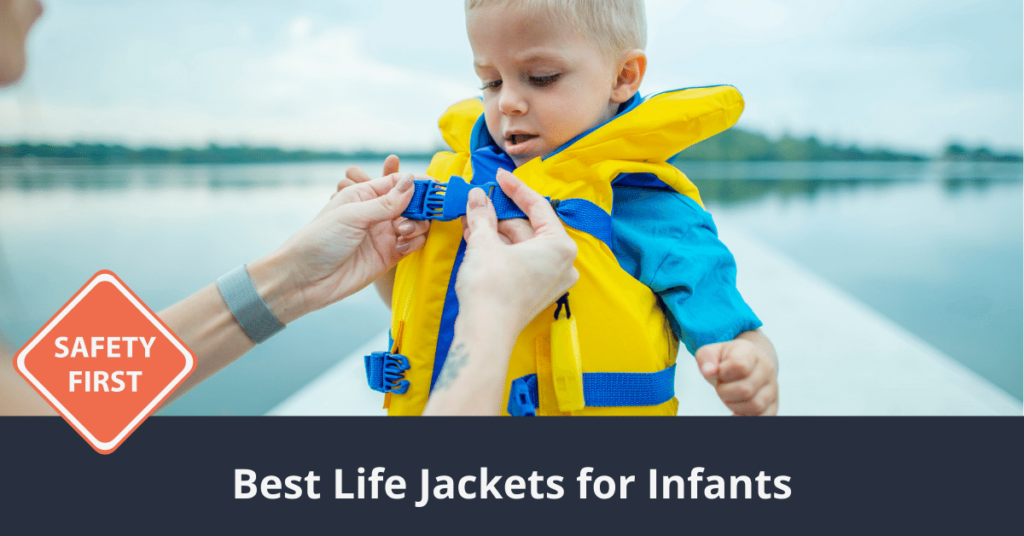

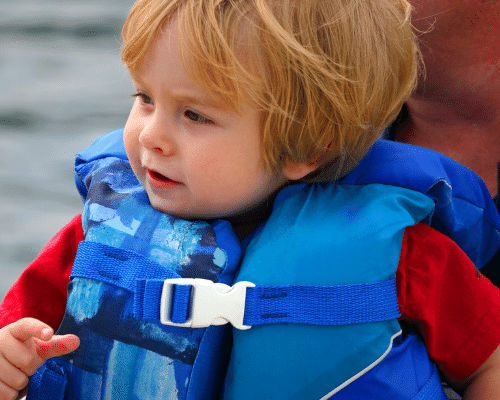
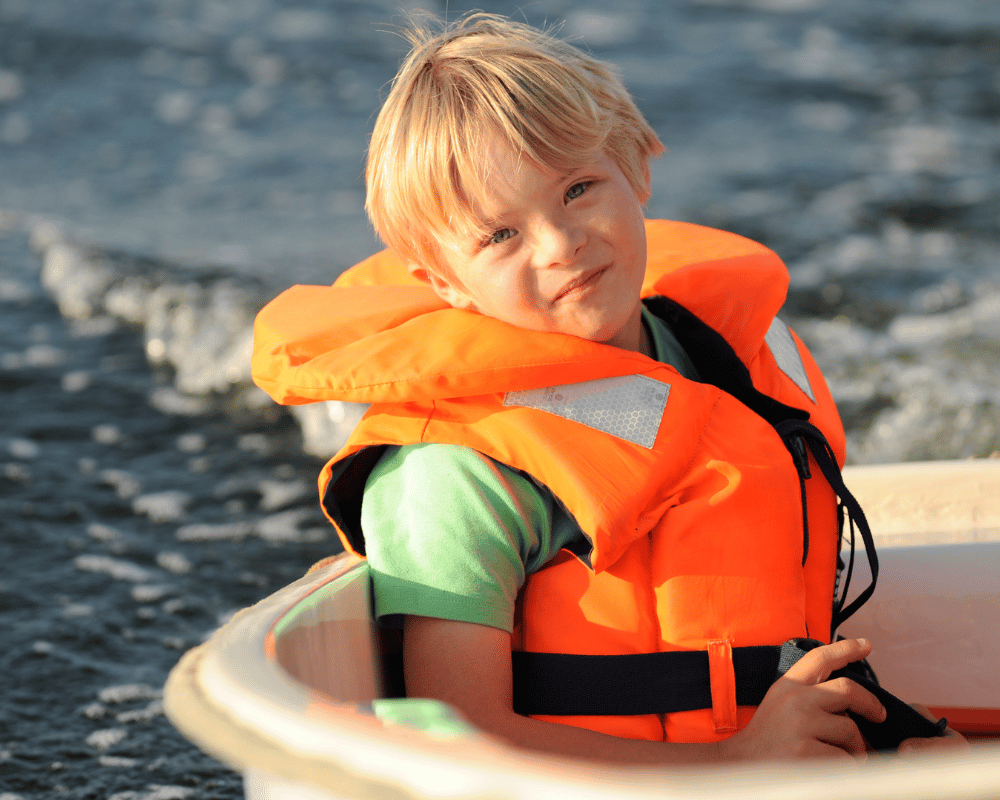









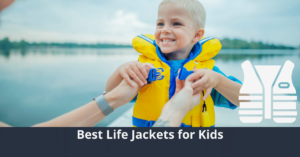
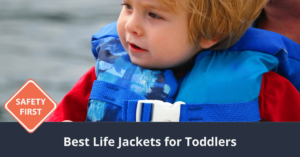
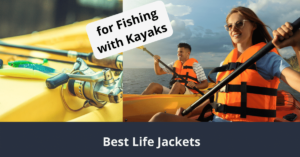
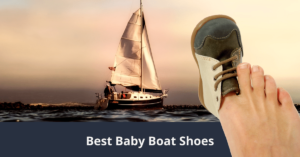
![7 Best Jet Ski Life Jackets with awesome fit [2023 guide] 20 Best Jet Ski Life Jacket](https://insmoothwaters.com/wp-content/uploads/2022/09/Best-Jet-Ski-Life-Jacket-300x157.png)
